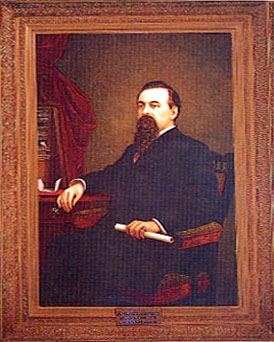-

Peter Burnett
1849–1851 -

John McDougal
1851–1852 -

John Bigler
1852–1856 -

J. Neely Johnson
1856–1858 -

John Weller
1858–1860 -

Milton Latham
1860–1860 -

John Downey
1860–1862 -

Leland Stanford
1862–1863 -

Frederick Low
1863–1867 -

Henry Haight
1867–1871 -

Newton Booth
1871–1875 -

Romualdo Pacheco
1875–1875 -

William Irwin
1875–1880 -

George Perkins
1880–1883 -

George Stoneman
1883–1887 -

Washington Bartlett
1887–1887 -

Robert Waterman
1887–1891 -

Henry Harrison Markham
1891–1895 -

James Budd
1895–1899 -

Henry Gage
1899–1903 -

George Pardee
1903–1907 -

James Gillett
1907–1911 -

Hiram Johnson
1911–1917 -

William Stephens
1917–1923 -

Friend Richardson
1923–1927 -

C.C. Young
1927–1931 -

James Rolph
1931–1934 -

Frank Merriam
1934–1939 -

Culbert Olson
1939–1943 -

Earl Warren
1943–1953 -

Goodwin Knight
1953–1959 -

Edmund G. "Pat" Brown
1959–1967 -

Ronald Reagan
1967–1975 -

Edmund G. "Jerry" Brown
1975–1983 -

George Deukmejian
1983–1991 -

Pete Wilson
1991–1999 -

Gray Davis
1999–2003 -

Arnold Schwarzenegger
2003–2011 -

Edmund G. "Jerry" Brown
2011–2019 -

Gavin Newsom
2019–Present

Romualdo Pacheco
1875–1875
Significant Facts
Born: October 31, 1831 in Santa Barbara, CA
Died: January 23, 1899 in Oakland, CA
Married: Mary McIntyre on October 31, 1863
Political Party: Republican
Family
Father: Romualdo Pacheco
Mother: Maria Ramona Carrillo
Wife: Mary McIntyre
Children: Maybella Ramona and Romualdo, Jr.
Find out more about the time period and interests of Romualdo Pacheco
Did You Know?
- A true outdoorsman, he is the only governor who claimed to have lassoed a grizzly bear
 Biography
Biography
The first California-born governor, Romualdo Pacheco was born in Santa Barbara before California was admitted to the Union as a state. Pacheco was the first governor of Mexican ancestry. At age seven, Pacheco was sent to school in Honolulu, Hawaii for five years. He attended Oahu Charity School, which was run by Andrew Johnson and his wife, friends of Pacheco’s stepfather.
At 15, Pacheco worked as an officer on his stepfather’s merchant ships. During the Mexican War Pacheco’s ship, which flew the Mexican flag, was captured by the U.S.S. Cyane. He was permitted to sail into San Francisco, where his vessel was captured again. He was allowed to leave after he pledged his allegiance to the United States. In 1848, Pacheco began working on his parents’ large estates. He was skilled at raising animal stock.
Pacheco started his career in politics in 1854, when he was elected as San Luis Obispo County judge–a post he held for four years. In 1857, he was elected to the California Senate was re-elected in 1861. Pacheco also served as California’s state treasurer from 1863 to 1866. Pacheco returned to the State Senate in 1869 in a contested election. His opponent, Patrick Murphy, asserted that Pacheco was not a qualified elector for the district. The Senate Committee on Elections investigated and found Murphy’s allegations to be without merit.
In 1871, Pacheco was elected to the office of Lieutenant Governor. He assumed the office of the governor when Governor Newton Booth resigned in 1875. He served as governor for approximately ten months and left office on December 9, 1875.
In his first run for a seat in the U.S. House of Representatives in 1877, Pacheco won by one vote. His opponent, Peter D. Wigginton, contested the results. Pacheco was unseated and his seat was restored to his opponent. Pacheco had a successful run for the House of Representatives in 1879 and served in Congress until 1883.
In 1890, President Harrison appointed Pacheco as U.S. Envoy Extraordinary and Minister Plenipotentiary to the Central America, a position he held from 1891 until 1893. Afterwards, Pacheco moved to San Francisco where he worked in the brokerage business. Pacheco then retired and lived the remainder of his life in Oakland, CA. He died from Bright’s disease on January 23, 1899.
 Bibliography
Bibliography
Books and Articles
- Biographical Directory of the U.S. Congress, 1774 – 2005
- Melendy and Gilbert. The Governors of California: From Peter H. Burnett to Edmund G. Brown, Talisman Press, 1965
- Pacheco Laid to Rest, Los Angeles Times, January 27, 1899
- Schaechtele. The Governors of California and their Portraits, California State Capitol Museum Volunteer Association, 1995
Websites
 Speeches
Speeches
- Inaugural Address delivered December 8, 1871
 Executive Orders and Proclamations
Executive Orders and Proclamations
Copyright © 2019 California State Library, All Right Reserved






